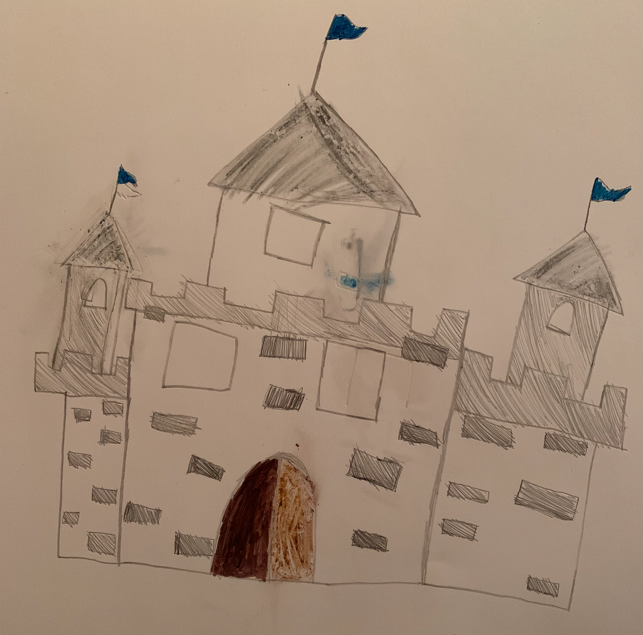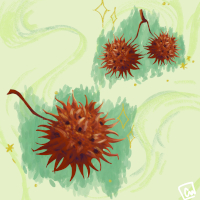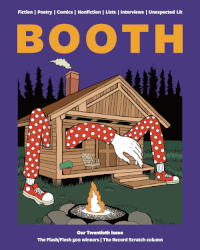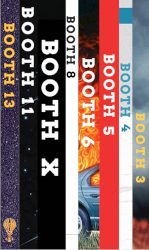This article is about the dramatized performance. For the short story, see The Rumpelstiltskin Understudies (Story). For the original fairy tale, see Rumpelstiltskin.
The Rumpelstiltskin Understudies is a play based on a short story of the same name by author Tucker Leighty-Phillips. The play is an experimental retelling of the popular fairy tale, intended to be performed by children who are given only a rudimentary understanding of the plot, creating a semi-improvisational performance.
In his original story, Leighty-Phillips included a series of index cards and prompted the reader to draw from the deck at specific moments. In this way, the variations on the cards represented the children’s performance, making the story a cross between a Mad Lib and a Choose Your Own Adventure narrative. In the dramatization, which Leighty-Phillips directed, he cast only children who were unfamiliar with the original Rumpelstiltskin tale, asking them to audition by reading dialogue from Willy Wonka & the Chocolate Factory and telling them the narrative events only after they’d been selected. The performers were given no lines of dialogue, only the events of the scene, which they were to ad lib. Leighty-Phillips was insistent on the children’s basic understanding of the premise being the most pertinent factor of the work, going so far as to encourage the cast to inform relatives and friends of the process. In some cases, the children were asked to avoid their families entirely, as Leighty-Phillips had created a list of untrustworthy or “blabbermouthed”[1] family members. Leighty-Phillips spoke of this process in an interview, claiming that “[children] are cognizant of the world in ways adulthood often undermines . . . any further direction would strip them of the wonder they bring to the stage.”[2]
The play debuted at Cold Pond Elementary School in Occurrence, Kentucky, on May 24, 2001, to a sold-out gymnasium, with many attendees curious about how the story would unfold. The play was performed four times over the course of the opening weekend before ending abruptly after a natural disaster struck the school, resulting in controversy and the play’s cancellation. The Rumpelstiltskin Understudies has not been performed since.
CASTING
Leighty-Phillips worked with Isadora Lemon, a fourth-grade teacher at the school, to identify appropriate cast members. The two had conflicting views over the casting process, as the director accused Lemon of primarily recommending students who were troublesome, truant, or otherwise in need of guidance and direction. Leighty-Phillips believed she was using the play as a means of motivating troubled students rather than suggesting the most suitable performers. Lemon, however, claimed this to be untrue, arguing that Leighty-Phillips came bearing an agenda that was not in the best interests of any students, let alone those needing mentorship. The pair were able to reach a compromise, as Leighty-Phillips agreed to cast a number of truant students given the added unpredictability they might bring to the performance. He even asked the cast to anonymously write down some of their past transgressions and slip them into his mailbox so that he could find ways to work them into the show. “If they were going to smoke, drink, or steal . . . wasn’t it better to do so on behalf of art?” he supposedly remarked backstage at a rehearsal.
Lemon has spoken about her relationship with the director, claiming his efforts to be “wrapped not in the ideas of children, but in the fact that sharing children’s ideas was ultimately his idea.”[2]
CAST
Although many of the play’s characters are similar to those in the original fairy tale, there are variations and additions. The daughter, typically unnamed, is named Mitsy in Leighty-Phillips’s production, as the actress playing her, Mitsy Curl, insisted the character have a name and selected her own. The role of the Rumpelstiltskin understudies is also unique to this production. In the casting process, Leighty-Phillips intentionally placed significant emphasis on Rumpelstiltskin’s importance in the play, creating a sense of desire among the students.
“He would walk back and forth on stage, saying, ‘Remember, Rumpelstiltskin is the star of the show, and everything revolves around our star,’” claimed one of the actors.
As a result, the audition process became quite competitive, and many believed Leighty-Phillips’s decision to cast Tommy Pepper, a fifth-grader who missed two auditions, was intended to be divisive, to create contempt amongst the children, and to make them so upset and angry that they’d consider sabotaging Pepper’s performance to claim his place as their own. After the announcement of Pepper’s casting, the director also announced that every actor/actress who had not been selected for the role would be performing as an alternate for Pepper, and they were told to remain in the wings for each performance. These characters became the titular understudies. Although the understudies are not technically written into the play, their presence looms over each performance, as they are given permission to take part should inspiration strike or should the Rumpelstiltskin actor fail to fulfill their duties. The addition of the understudies further advanced the assumption that Leighty-Phillips was encouraging sabotage. A note on their creation in Leighty-Phillips’s original director’s notes states that he wanted to increase the likelihood of “orchestrated outside intervention.”
| CHARACTER | CAST |
| The Miller | Simon Napier |
| Mitsy (The Daughter) | Mitsy Curl |
| The King | Harley McCracken |
| Rumpelstiltskin | Tommy Pepper |
| The Firstborn | Lucy Grueller |
| The Rumpelstiltskin Understudies | Byron Burn, Molly Abrams, Haley Omar, Bryndyn Trinks, Keith Charles, Frida Hardin, Wanda Hardin, Scott Cotton, Blake Sturgeon, and up to four additional performers |
DEVELOPMENT AND PRODUCTION
The play was self-funded by the director, although he received financial support through a pair of modest arts grants. Cold Pond Elementary was selected as the venue because Leighty-Phillips wanted to work within the region of Eastern Kentucky where he grew up, and the school was willing to host the play for free, so long as Cold Pond students were cast and proceeds were donated to the school’s arts department. Students were also asked to create set pieces, although none had prior experience, and were given complete authority in their design, being told only the basics of the setting (“castle tower” or “farmer’s house”). This resulted in a series of decorated poster boards that were too small for the stage; the students misjudged the size of what they were asked to create. Leighty-Phillips insisted on using the pieces. As a result, some performers pretended to be giants, going so far as to stomp through scenes and simulate deep, booming voices as they spoke.

PERFORMANCES
The opening performance lasted just nineteen minutes, as many of the performers suffered from stage fright and rushed through their scenes. Notable moments of opening night included the following:
- During Mitsy’s first attempt at guessing Rumpelstiltskin’s name, she guessed the names of various Pokémon, sparking an impromptu call-and-response between cast members who provided more names.
- Rumpelstiltskin understudy Scott Cotton entered the stage as a professional wrestler and challenged Pepper’s character to a duel. The scene ended when Mitsy abruptly guessed Rumpelstiltskin’s name, banishing both characters.
- The parent of an unnamed cast member was banned from backstage after encouraging the children to reference a local business they owned. The business owner has not been publicly named.
The director insisted on not speaking to the cast after each performance, as he did not want to unintentionally sway the actors by offering value judgments on improvised aspects of that night’s show. A number of parents and faculty spoke to Leighty-Phillips about the children’s continued use of name-calling and insults throughout the opening performance (many children relied heavily on the term “buttface”) and asked him to ban denigrating names on the grounds of inappropriate, impolite behavior. Leighty-Phillips refused, stating that the children were practicing only what they had learned elsewhere.[3]
After the Saturday evening performance, Pepper was replaced as Rumpelstiltskin after repeating some of his improvisations from the matinee show, most notably his choice to perform a number of lines via an impression of the Squidward character from SpongeBob SquarePants. Rather than committing to a replacement, Leighty-Phillips assigned all the understudies to play the title role, replacing Pepper with the nine alternates. While performing, the nine new Rumpelstiltskins raced to be the first to deliver a line or respond to another cast member, and they created factions within the nine to synchronize lines or make inside jokes on stage. One parent deemed this performance to be “unbearable” [citation needed].
During the opening of the matinee performance on Sunday, May 26, 2001, the stage collapsed after a sinkhole opened beneath the gymnasium. There were no fatalities or serious injuries, although many students suffered scrapes and bruises. The play was permanently closed after Leighty-Phillips engaged in a public scuffle with school officials and the fire department, with bystanders claiming the director demanded the performance continue, citing the natural disaster as “God and Mother Nature’s editorial presence.” Leighty-Phillips was removed from the property, and all future performances were canceled. The play has not been performed since.
CRITICAL RECEPTION AND AFTERMATH
The only published review of The Rumpelstiltskin Understudies came from the Saturday edition of the Cold Pond Gazette, which claimed Leighty-Phillips’s work was “a slice of something straight from New York City, an idea so whimsical and niche that it could belong only to the Big Apple” and claimed that the children were “charming, but wholly directionless and uninspired.” The Monday, May 25, edition included a follow-up editor’s note that described the sinkhole as “the unseen hand of a higher power, exposing [Leighty-Phillips] and banishing him back to the big city” but also noted that the performances had raised over $1,200 for the elementary school’s arts department, enough to buy a new set of Practice Babies and to fund the school’s fall performance, a traditional production of The Three Little Pigs directed by Isadora Lemon.
Leighty-Phillips has since fallen out of the public eye. During the filming of Sinkhole, Kentucky, a documentary based on the events, Leighty-Phillips agreed to an interview, but one never transpired, as he sent a child in his place.
SEE ALSO
______________________________



